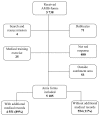The epidemiology of medical emergency contacts outside hospitals in Norway--a prospective population based study
- PMID: 20167060
- PMCID: PMC2836273
- DOI: 10.1186/1757-7241-18-9
The epidemiology of medical emergency contacts outside hospitals in Norway--a prospective population based study
Abstract
Introduction: There is a lack of epidemiological knowledge on medical emergencies outside hospitals in Norway. The aim of the present study was to obtain representative data on the epidemiology of medical emergencies classified as "red responses" in Norway.
Method: Three emergency medical dispatch centres (EMCCs) were chosen as catchment areas, covering 816 000 inhabitants. During a three month period in 2007 the EMCCs gathered information on every situation that was triaged as a red response, according to The Norwegian Index of Medical Emergencies (Index). Records from ground ambulances, air ambulances, and the primary care doctors were subsequently collected. International Classification of Primary Care-2 symptom codes (ICPC-2) and The National Committee on Aeronautics (NACA) Score System were given retrospectively.
Results: Total incidence of red response situations was 5 105 during the three month period. 394 patients were involved in 138 accidents, and 181 situations were without patients, resulting in a total of 5 180 patients. The patients' age ranged from 0 to 107 years, with a median age of 57, and 55% were male. 90% of the red responses were medical problems with a large variation of symptoms, the remainder being accidents. 70% of the patients were in a non-life-threatening situation. Within the accident group, males accounted for 61%, and 35% were aged between 10 and 29 years, with a median age of 37 years. Few of the 39 chapters in the Index were used, A10 "Chest pain" was the most common one (22% of all situations). ICPC-2 symptom codes showed that cardiovascular, syncope/coma, respiratory and neurological problems were most common. 50% of all patients in a sever situation (NACA score 4-7) were > 70 years of age.
Conclusions: The results show that emergency medicine based on 816 000 Norwegians mainly consists of medical problems, where the majority of the patients have a non-life-threatening situation. More focus on the emergency system outside hospitals, including triage and dispatch, and how to best deal with "everyday" emergency problems is needed to secure knowledge based decisions for the future organization of the emergency system.
Figures
Similar articles
-
Acute chest pain - a prospective population based study of contacts to Norwegian emergency medical communication centres.BMC Emerg Med. 2011 Jul 21;11:9. doi: 10.1186/1471-227X-11-9. BMC Emerg Med. 2011. PMID: 21777448 Free PMC article.
-
Involvement in emergency situations by primary care doctors on-call in Norway--a prospective population-based observational study.BMC Emerg Med. 2010 Mar 6;10:5. doi: 10.1186/1471-227X-10-5. BMC Emerg Med. 2010. PMID: 20205933 Free PMC article.
-
Variations in contact patterns and dispatch guideline adherence between Norwegian emergency medical communication centres--a cross-sectional study.Scand J Trauma Resusc Emerg Med. 2014 Jan 8;22:2. doi: 10.1186/1757-7241-22-2. Scand J Trauma Resusc Emerg Med. 2014. PMID: 24398290 Free PMC article.
-
Incidence of emergency contacts (red responses) to Norwegian emergency primary healthcare services in 2007--a prospective observational study.Scand J Trauma Resusc Emerg Med. 2009 Jul 8;17:30. doi: 10.1186/1757-7241-17-30. Scand J Trauma Resusc Emerg Med. 2009. PMID: 19586530 Free PMC article.
-
State-of-the-art management of the acutely unwell child.Anaesthesia. 2022 Nov;77(11):1288-1298. doi: 10.1111/anae.15816. Epub 2022 Sep 12. Anaesthesia. 2022. PMID: 36089884 Free PMC article. Review.
Cited by
-
General practitioners not available - out-of-hospital emergency patients handled by anaesthesiologist in a large Norwegian municipality.Scand J Prim Health Care. 2021 Jun;39(2):240-246. doi: 10.1080/02813432.2021.1922833. Epub 2021 Jun 7. Scand J Prim Health Care. 2021. PMID: 34096461 Free PMC article.
-
Air ambulance services in the Arctic 1999-2009: a Norwegian study.Int J Emerg Med. 2011 Jan 27;4:1. doi: 10.1186/1865-1380-1-1. Int J Emerg Med. 2011. PMID: 21407997 Free PMC article.
-
Reasons for encounter by different levels of urgency in out-of-hours emergency primary health care in Norway: a cross sectional study.BMC Emerg Med. 2017 Jun 24;17(1):19. doi: 10.1186/s12873-017-0129-2. BMC Emerg Med. 2017. PMID: 28646858 Free PMC article.
-
Identification of new demands regarding prehospital care based on 35,188 missions in 2018.BMC Emerg Med. 2021 May 24;21(1):63. doi: 10.1186/s12873-021-00456-w. BMC Emerg Med. 2021. PMID: 34030660 Free PMC article.
-
Potential cardiac arrest - an observational study of pre-hospital medical response.Scand J Prim Health Care. 2016 Jun;34(2):130-4. doi: 10.3109/02813432.2016.1160630. Epub 2016 Apr 19. Scand J Prim Health Care. 2016. PMID: 27092724 Free PMC article.
References
-
- Norwegian Medical Association. (Norwegian Index of Emergency Medical Assistance) 2.1. Stavanger: The Laerdal Foundation for Acute Medicine; 2005. Norsk indeks for medisinsk nødhjelp.
-
- Regional Health Authorities. Traumesystem i Norge (Trauma care system in Norway) http://www.helse-sorost.no/stream_file.asp?iEntityId=1567
-
- Ministry of Health and Care Services. Stortingsmelding 43 (1999-2000) Om akuttmedisinsk beredskap. (About emergency preperedness) http://www.regjeringen.no/nb/dep/hod/dok/regpubl/stmeld/19992000/stmeld-...
-
- Office of the Auditor General of Norway. Riksrevisjonens undersøkelse av akuttmedisinsk beredskap i spesialisthelsetjenesten. (The OAG's investigation of emergency medical preparedness in the specialist health service. English summary) http://www.riksrevisjonen.no/Search/sider/Results.aspx?k=akuttmedisin
MeSH terms
LinkOut - more resources
Full Text Sources
Medical


